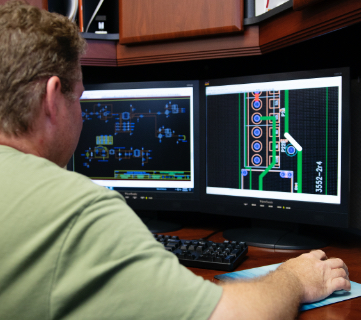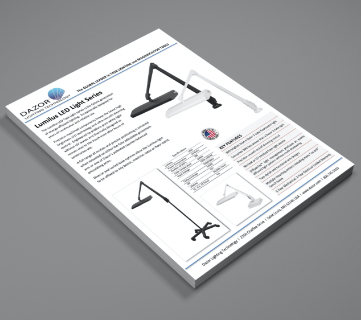Benefits of Task Lighting
by Mark Hogrebe, PhD
(this article appeared in the National Assoc. of Independent Lighting Distributors, Inc. News)
There is a renewed interest in task lighting. "Renewed" because task lighting was all the world had known before our dependence on high-output overhead fixtures. Prior to electrically powered lighting fixtures, seeing at night was accomplished through the use of "task lights" such as candles and oil and kerosene lamps. When the power of electricity was first harnessed, it was applied to crude incandescent "task lights."
For many years, task lighting continued to be the best option for seeing indoors. It was a long time before overhead fixtures would make a significant impact on how work areas were lighted.
First, the technology had to be developed so that overhead fixtures could produce adequate amounts of quality light. For buildings that had been built prior to the application of electricity, it was difficult to integrate overhead lighting into the old structures. Finally, architects had to discover how to efficiently incorporate overhead lighting into new buildings.
Despite obstacles to subduing our need for task lighting, America was convinced that task lights were not necessary in the presence of powerful overhead fixtures. We were shown that adequate foot-candles on the desk top could be produced from overhead lighting - but at what cost? In recent years we have begun to discover some of the costs of total reliance on overhead lighting to illuminate the work surface. The key is total reliance. The best approach for designing an energy-efficient and visually comfortable lighting installation is effective integration of overhead and task lighting.
Some of the major impacts of rediscovering task lighting for our work environment are discussed below.
Benefits for Individuals
Task lighting and productivity. Much research has been conducted on the relationship between lighting conditions and worker productivity. Surveys continue to find that poor lighting and eyestrain are frequent worker complaints. Although it may be difficult to demonstrate a direct cause-and-effect relationship between lighting and performance in real world settings, we can make some common sense observations.
First, we must be comfortable to maintain productivity over the course of a day. There are enough demands and distractions that compete for our energy and concentration. Straining to see should not be one of them.
Seeing should be effortless and automatic. We spend a great deal of time and money trying to make ourselves comfortable so that we can be more efficient and productive. Yet frequently, proper lighting is neglected. If lighting is so poor as to make workers uncomfortable, then efficiency is going to decrease over the long term.
However, once lighting reaches a "critical comfort level," better lighting above and beyond that level will probably not increase productivity. Once lighting surpasses the critical comfort level, many other environmental factors interact to influence productivity.
Task lighting and vision differences.
Our ability to see differs from person to person, and within ourselves, on different occasions. When we are tired or sick, we may see less well than when we are healthy and fresh.
The visual capabilities of individuals of the same age can vary greatly. Older people need substantially more light to see than younger people. Research indicates that the visual performance of those in their 20s is about eight times better than those in their 60s, and almost four times better than those in their 50s.
This increased need for light is due to a number of biological facts in the aging process. For example, the muscle in our eye called the iris, expands and contracts to control the amount of light entering our eye. As with all our muscles, the iris loses some of its flexibility in the aging process, and doesn't open as wide. More light is needed to compensate for the reduced ability of the iris to open wide.
Not only are there obvious vision differences between people, but different tasks have unique lighting requirements. Lighting demands for a video display terminal (VDT) operator are different from a proof reader, which are different from a graphic artist working at a large table where accurate color perception is critical.
Task lighting gives user control.
The major advantage of an adjustable-arm task light is that the user controls the lighting of his or her immediate work environment.
The key is "adjustable-arm" task lighting to give the user maximum control of the light level for optimal comfort. Our posture changes during the day. Our tasks vary to some degree. If we have windows, light in the room changes from morning to evening.
In response to these changing conditions, we need to adjust the lighting levels directed on our work in order to reduce eyestrain and fatigue. By raising, lowering, and tilting an adjustable-arm task light, the user determines how much light is needed, and the best angle required, to avoid direct glare and reflections.
A task light permits an individual to compensate for fluctuations within one's visual acuity from time to time, as well as for variations in ambient lighting.
Further control is provided by task lights that use a parabolic louver to direct light onto the work surface. The louver light control system is ideal for use around computers where you want to eliminate light "spill" onto the screen. The parabolic louver directs light output onto the source document and prevents "wash-out" on the computer screen.
A major advantage of a louver light control system versus the asymmetric method (directing light from the reflector at one angle) is the elimination of direct glare. With the louver system, you cannot see the bright bulb when the lamp head reaches eye level.
Task lighting mounting systems.
There are a variety of options for mounting task lighting in the work setting. Popular methods include a clamp base that attaches to the edge of a desk/table, and the weighted base that sits on top of a desk. Task lights can be mounted on stationary pedestal floor stands or movable caster floor stands.
The newest mounting systems attach task lights to the vertically slotted channels in workstation wall partition panels. Wall partition mounting frees-up valuable desktop space and eliminates the problem of "lack of edges" encountered by clamp-on versions. One option is a single-mount holder which the user places in the channel closest to the work area to be illuminated.
Another mounting option is a track-mount which provides greater illumination coverage for the work surface. The track spans the width of a wall panel and mounts in the slotted channels on both sides. A movable pivot holder for the task light slides along the track length to the desired position. The key factors in selecting a wall partition mounting system are ability to fit the many styles of standards and deep partitions; ease of installation; firm and sturdy mount; versatility to mount more than one specific task light model; a cord management system; and compatibility with standard track accessory items such as hanging paper trays and file folders.
Task lighting and magnification.
Do we need a task light if we have magnification? The answer is yes, because magnification is only half the solution for achieving good vision. Proper lighting is of equal importance. Take an extreme example. How much good would magnification do in the dark? The benefits derived from visual aids such as magnifiers and prescription glasses are entirely dependent upon the lighting conditions in which they are used.
Proper task lighting allows us to get the maximum benefit from a visual aid, and may even allow for reduced magnification. Increasing the amount of light (brightness) directed onto a task will help compensate for small print size or poor contrast. Examples of poor contrast include faded print on white paper, dark print on a dark background, or dim characters on a computer screen.
Bottom-line benefits for business.
The use of a lighting system which integrates task and overhead lighting can have a direct impact on the bottom line by lowering utility dollars.
Instead of trying to maintain proper lighting levels on desktops from overhead fixtures, task lights can do a better job in providing adequate foot-candles. A task light using an 18-watt compact fluorescent will consume far less energy than a typical overhead lighting fixture.
A work environment can maintain lower levels of overhead light by illuminating desktops with energy-efficient task lights. For examples consider an office with 16 workstations illuminated by 16 overhead fixtures each with four T8 32-watt fluorescents. The total wattage when all fixtures are operating is 2,048. If each fixture used two T8 instead of four, and each workstation was equipped with an 18-watt task light, energy consumption would be reduced by 36 percent!
A recent example demonstrates the energy waste that occurs all too frequently. An office manager remarked that, "we don't need those (task lights) to control glare on our computer screens. We installed these filters on the screens to block out glare." This makes no sense in terms of cost reduction and energy conservation. First flood the room with light and then block it out with filters. It is like turning the heat up to 90 degrees in the winter and then opening the window to maintain the right temperature.
Other ways in which the use of task lighting can help control costs are by reducing maintenance costs. Task lights are easy to install, keep clean, and change bulbs. When offices made from wall partition furniture systems are rearranged, task lights are easily moved. Proper lighting is achieved without much worry about the location of overhead fixtures.
Environmental benefits.
Finally, task lighting can have a significant environmental impact by reducing energy consumption of a building's lighting system.
The U.S. Environmental Protection Agency's (EPA) "Green Lights" program has brought the need for energy-efficient lighting into public awareness. The EPA estimates that lighting accounts for 20 to 25 percent of the electricity used annually in the United States. Lighting for industry, offices, stores, and warehouses represents from 80 to 90 percent of the total lighting electricity use. If energy-efficient lighting were used everywhere it was profitable, the electricity required for lighting would be cut by 50 percent, and aggregate national electricity demand would be reduced by 10 percent. This reduction in demand would significantly reduce power plant emissions, pollutants, and wastes. Many past issues of NAILD NEWS have devoted articles to the environmental impact of lighting and specifically, how to calculate savings in environmental pollutants (NAILD NEWS, December 1990).
In summary, a system that integrates overhead and adjustable-arm task lighting makes good dollar sense for business and the environment.
Task lighting makes good psychological sense by giving individuals control over their own workspace lighting.
If you have any questions about the task/ambient lighting approach, please call the Green Lights Technical Hotline at 202-862-1145.
About the Author:
Mark Hogrebe is the former president of Dazor Manufacturing Corp., a leading manufacturer of task lighting. His primary interest areas include the psychological impact of lighting in the workplace, especially as it relates to individual differences in visual acuity and comfort, and worker productivity. Other interest areas include the role of task lighting as a significant component in energy-efficient lighting installations. Hogrebe holds a Ph.D. in Educational Psychology from the University of Georgia, a master of arts degree from the University of Akron, and a bachelor of arts degree from Quincy College.




